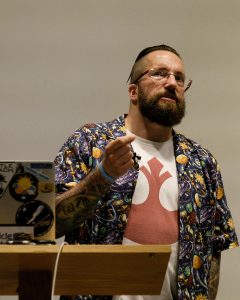June 8, 2016
ESAs comet chasing mission Rosetta
Dr Matt Taylor
Report by: Mike Meynell
For the final lecture of our 2015/16 season, Flamsteed members were given a real treat when Dr Matt Taylor from ESA came to talk about the Rosetta mission. Matt is the Project Scientist for this mission, working as the interface between the scientists responsible for the experiments on the mission and the ESA mission operation team.
The Rosetta Mission is the third cornerstone mission the ESA programme Horizon 2000. The aim of the mission is to map the comet 67-P/Churyumov-Gerasimenko by remote sensing, to examine its environment insitu and its evolution in the inner solar system.
During his presentation to the Flamsteed, Matt provided a fascinating overview of the challenges of planning a mission of such complexity, and gave us an insight into some of the scientific discoveries that have already been made. There is no doubt that these discoveries will continue over the coming decades, as scientists continue to analyse the huge amount of data which the mission has gathered in more detail.
Finally, Matt updated us with the plans for the end of mission in September 2016, when Rosetta is expected to crash land on the comet itself, joining the Philae lander on the surface, thus ending one of the most fascinating space exploration missions of recent times… a mission which has truly captivated public interest, and has made huge strides in improving our understanding of comets and the history of the early solar system.
Our sincere thanks to Matt for providing such an informative and entertaining talk to Flamsteed members. It’s a talk that will live long in the memory, and we wish Matt all the very best for the future. We hope he can find the time to return to the Flamsteed one day.
No Matt Taylor lecture would be complete without a #mattselfie, so here it is!:
#mattselfie @Flamsteed @ESA_Rosetta pic.twitter.com/m8tDgFYR2Y
— Matt Taylor (@mggtTaylor) June 8, 2016
Pictures from the Evening (by Mike Meynell):
Posted under: Flamsteed, Flamsteed Lecture, Meeting Report









You must be logged in to post a comment.